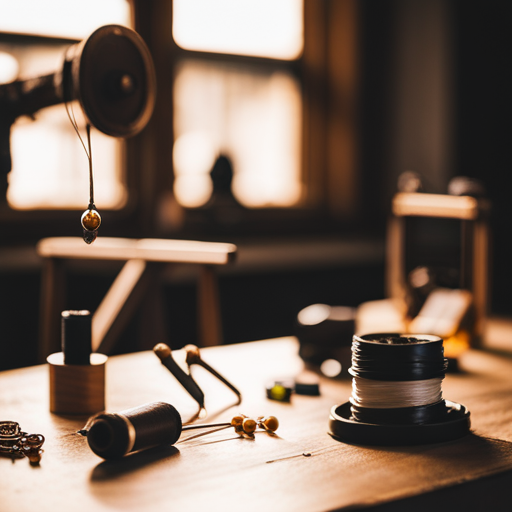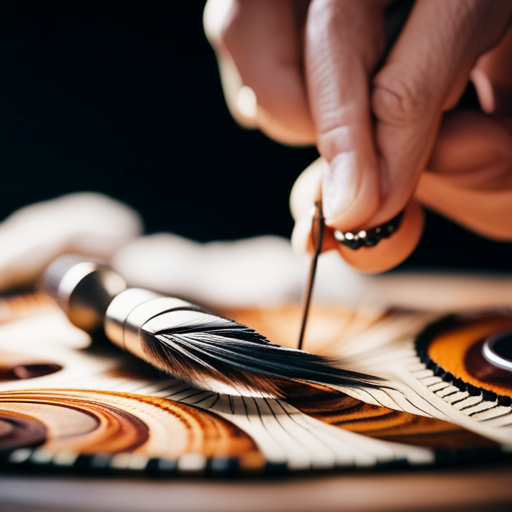Embark on an enthralling journey through the intricate world of fly patterns, where science and art converge to unlock the secrets of successful angling.
Delve into the depths of entomology, fish vision, and behavioral science to unravel the physics and biology behind effective fly design and presentation.
Discover how the application of psychology enhances fly selection, as we explore the nuanced strategies that lure even the most elusive of fish.
The Role of Entomology in Fly Patterns
The effectiveness of fly patterns is significantly influenced by the study of entomology, as it provides crucial insights into the natural behavior and appearance of insects that fish feed on. Entomology basics form the foundation for understanding the life cycles, behaviors, and habitats of aquatic insects. This knowledge is indispensable for fly anglers as it enables them to replicate the appearance and behavior of natural insects when creating fly patterns. Understanding the entomology of a particular fishing location allows anglers to match the hatch, imitating the insects that are currently present and actively being consumed by the fish.
In the realm of fly tying techniques, entomology plays a critical role. By closely observing the size, shape, color, and movement of insects, fly tyers can craft patterns that closely resemble the natural prey of fish. This involves meticulous attention to detail to accurately replicate the segmented bodies, wings, and legs of the insects. Furthermore, entomological knowledge helps in selecting the appropriate materials for constructing flies, ensuring that they possess the lifelike qualities necessary to deceive fish.
A thorough understanding of entomology enriches the process of fly pattern creation, resulting in imitations that effectively entice fish to strike.
Understanding Fish Vision and Behavior
Understanding fish vision and behavior is integral to the design and selection of effective fly patterns. This allows fly anglers to create imitations that are visually appealing and behaviorally convincing to the fish they are targeting.
Fish perception plays a crucial role in determining how they respond to fly patterns. Fish have different visual capabilities based on their habitat and feeding behavior. For instance, trout have excellent color vision and can see a broad spectrum of colors, whereas species like carp may have more limited color perception. Understanding these differences is essential when designing fly patterns for specific fish species.
Moreover, the predator-prey dynamics influence fish behavior. Fish are attuned to the behavior of their prey, and effective fly patterns must mimic the natural movement and behavior of the insects or other organisms that fish prey upon.
Physics of Fly Design and Presentation
Visualizing the intricate physics of fly design and presentation is paramount for ensuring that the resulting patterns effectively mimic the natural movement and behavior of the prey, ultimately attracting and enticing the targeted fish species.
-
Fly Aerodynamics: Understanding the principles of aerodynamics is crucial in designing fly patterns that can achieve accurate casting and precise presentation. Factors such as air resistance, drag, and lift must be considered to create flies that can be effectively maneuvered through varying wind conditions.
-
Lure Movement: The movement of the fly in the water is a critical aspect of its effectiveness. By comprehending the dynamics of water resistance and the behavior of different materials underwater, fly patterns can be designed to simulate the natural movement of insects or small prey, thereby increasing their appeal to fish.
-
Weight Distribution: Proper weight distribution in the fly pattern is essential for achieving the desired presentation. Balancing the weight in a fly allows for accurate casting and controlled sinking or floating, enabling the angler to effectively mimic the behavior of natural prey.
-
Material Selection: Selecting the right materials based on their density, buoyancy, and flexibility is key in creating flies that can accurately replicate the appearance and movement of natural prey, increasing their attractiveness to the targeted fish species.
Biological Triggers for Fish Strikes
Exploring the biological triggers that prompt fish strikes is crucial for developing fly patterns that effectively elicit predatory responses from targeted fish species.
One of the key biological triggers is sensory perception. Fish are highly sensitive to visual, olfactory, and tactile stimuli. Effective fly patterns should mimic the natural prey of the targeted fish species, taking into account the specific sensory cues that trigger predatory behavior. For example, incorporating realistic colors, shapes, and sizes can enhance the likelihood of a fish striking the fly.
Additionally, natural movement is another crucial biological trigger. Fish are attuned to the movements of their prey, and fly patterns that accurately replicate the natural movement of insects, crustaceans, or other aquatic organisms can significantly increase the chances of eliciting a strike. Understanding the biomechanics of prey movement and incorporating this knowledge into fly pattern design is essential for triggering predatory responses in fish.
Applying Psychology to Fly Selection
An understanding of the psychological factors influencing fish behavior is essential when applying psychology to fly selection, as it complements the biological triggers discussed previously and aids in the development of effective fly patterns.
When considering the psychological influences on fish behavior, several key factors come into play:
-
Color Perception: Fish perceive colors differently based on their environment and feeding habits. Understanding the specific color preferences of the target species can significantly impact fly pattern effectiveness.
-
Size and Shape Recognition: Fish have evolved to recognize and target certain prey based on size and shape. Matching the size and silhouette of the natural prey through fly selection can trigger more strikes.
-
Movement and Behavior: Mimicking the natural movement and behavior of aquatic insects or baitfish can elicit strong feeding responses from fish. Understanding the behavioral cues that attract fish is crucial in designing effective fly patterns.
-
Sensory Stimuli: Incorporating sensory stimuli such as scent, sound, or vibration into fly patterns can enhance their effectiveness by appealing to multiple senses of the fish.
Considering these psychological influences when selecting fly patterns can greatly enhance angler success by increasing the likelihood of triggering feeding responses from fish.
Frequently Asked Questions
Can I Use the Same Fly Pattern for Different Types of Fish?
When considering fly patterns for different types of fish species, adaptability is key. While certain patterns may be effective for multiple species, it’s important to research the specific feeding behaviors and preferences of each fish.
How Do Environmental Factors, Such as Water Temperature and Weather, Affect Fly Patterns?
Environmental influences such as water temperature and weather play a crucial role in fly selection for fishing success. Water conditions impact fly effectiveness, with colder temperatures often requiring smaller, more natural patterns, while warmer conditions may call for larger, more vibrant flies.
What Are Some Common Mistakes That Fly Fishermen Make When Choosing Fly Patterns?
Common misconceptions in fly pattern selection often stem from overlooking fish behavior and habitat conditions. Matching patterns requires understanding insect life cycles and water dynamics. To avoid mistakes, anglers must prioritize observation and adaptability.
Are There Any Ethical Considerations When It Comes to Using Certain Fly Patterns?
Ethical considerations in fly pattern selection are crucial, impacting fish welfare and conservation efforts. Fly pattern versatility allows anglers to adapt to changing conditions, but it’s important to prioritize ethical practices to preserve aquatic ecosystems.
How Can I Determine the Best Time of Day to Use Specific Fly Patterns?
Determining the effectiveness of specific fly patterns depends on various factors, including the time of day. Consider fish species compatibility, environmental impact, and ethical considerations. Research and observation can help optimize fly pattern selection.
Conclusion
In conclusion, the intricate science behind effective fly patterns encompasses:
- Entomology: understanding the insects that fish prey upon and mimicking their appearance and behavior in the fly pattern.
- Fish vision and behavior: taking into account how fish perceive and react to different colors, shapes, and movements.
- Physics of design and presentation: considering the hydrodynamics of the fly in the water and how it behaves when cast and retrieved.
- Biological triggers for fish strikes: incorporating features that trigger a predatory response in fish, such as realistic movement or vibrations.
- Psychological factors: recognizing that fish may have preferences or biases towards certain patterns based on their past experiences.
Despite the meticulous research and understanding put into creating these patterns, it is ultimately up to the fish to decide whether they are effective. The irony lies in the fact that while we strive for perfection, the fish’s unpredictable nature reminds us that success is ultimately in their hands.




